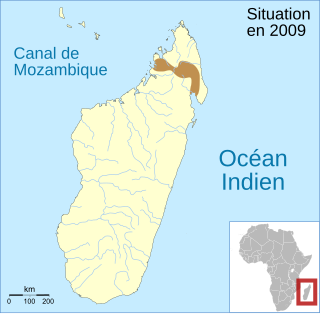
The red-spotted toad is a toad in the family Bufonidae found in the southwestern United States and northwestern Mexico.

The Texas toad is a species of medium-sized toad that occurs in the southern United States and northern Mexico. It breeds in temporary water pools after heavy rains.

Incilius ibarrai is a species of toad in the family Bufonidae. It is found in the central and southern highlands of Guatemala and adjacent Honduras. The specific name ibarrai honors Jorge Alfonso Ibarra (1921–2000), then-director of the Guatemalan National Natural History Museum.

Incilius leucomyos is a species of toad in the family Bufonidae. It was described in 2000 and is endemic to the Atlantic versant of the north-central Honduras.

Incilius pisinnus is a species of "true" toads in the family Bufonidae. It is endemic to Mexico and known from the Tepalcatepec Valley in Michoacán. Prior to its description in 2005, it was mixed with Incilius coccifer and Incilius cycladen. The specific name pisinnus, from the Latin word for "small", refers to the comparatively small size of this species among its close relatives.
The Chirinda toad, Chrinda forest toad, Mashonaland toad or Boulenger's earless toad is a species of toad in the family Bufonidae with a restricted distribution in eastern Zimbabwe and western Mozambique.
Callixalus is a genus frogs in the family Hyperoliidae. It is monotypic, being represented by a single species, Callixalus pictus. It is found in the eastern Democratic Republic of the Congo and western Rwanda. It is sometimes known as the African painted frog.
Leptopelis jordani is a species of little-known frog in the family Arthroleptidae. Common name Congulu forest treefrog has been coined for it.
Microhyla borneensis, also known as the Matang narrow-mouthed frog, is a species of microhylid frog found in the Matang Range in Sarawak, Borneo. It was once the smallest known frog from the Old World. Adult males of this species have a snout-vent length (SVL) of 10.6–12.8 mm (0.42–0.50 in), but adult males can reach a maximum of 13 mm (0.51 in),and adult females of this species have a snout-vent length of 16–19 mm (0.63–0.75 in), Tadpoles measure just 3 mm.

Rhombophryne minuta is a species of frog in the family Microhylidae. It is endemic to northern Madagascar. It has been mixed with other species such as Rhombophryne mangabensis; it is known with certainty only from the Marojejy National Park.

Sphenophryne cornuta is a species of frogs in the family Microhylidae. It is endemic to New Guinea where it is widespread and found both in the Western New Guinea (Indonesia) and Papua New Guinea. Common name horned land frog has been proposed for it.
Phrynobatrachus ogoensis is a species of frog in the family Phrynobatrachidae. It is endemic to Gabon and is known from its type locality, Lambaréné in the Moyen-Ogooué Province, and from the Ramba Village in the Ogooué-Ivindo Province, in the buffer zone of the Lopé National Park.
Poyntonia, is a monotypic frog genus in the family Pyxicephalidae. It is also known under common names reserve frogs and marsh frogs.
Thorius arboreus, commonly known as the arboreal minute salamander, is a species of salamander in the family Plethodontidae. It is endemic to Sierra de Juarez, Oaxaca, Mexico. The specific name arboreus, derives from the Latin word arbor, meaning tree, referring to the arboreal habitat of this species.
Ptychadena submascareniensis is a species of frog in the family Ptychadenidae. This West African frog is found on the Nimba Range of Ivory Coast, Guinea, and Liberia, and on the Loma Mountains of Sierra Leone.
Ptychadena tournieri is a species of frog in the family Ptychadenidae. It is a widespread species in West Africa and found in Senegal, Gambia, Guinea-Bissau, Guinea, Sierra Leone, Liberia, and Ivory Coast, as well as in Togo and Benin; it is assumed to occur in Ghana and southeastern Burkina Faso, although it has not been recorded there. On the other hand, some records may refer to other species; the Amphibian Species of the World excludes Gambia and Togo from the distribution. Common names Liberia grassland frog and Tournier's rocket frog are sometimes used.
Ptychadena wadei is a species of frog in the family Ptychadenidae. It is endemic to Ethiopia and only known from a small area southeast of Lake Tana, in the upper reaches of the Blue Nile. The specific name wadei honours Edward O.Z. Wade, an English illustrator and herpetology enthusiast who drew some of the illustrations accompanying the species description. Common name Wade's grass frog has been coined for it.
Incilius guanacaste is a species of toads in the family Bufonidae. It is endemic to the Cordillera de Guanacaste in northern Costa Rica. The species is only known from the slopes of Miravalles Volcano and Rincón de la Vieja Volcano.

Incilius is genus of toads in the true toad family, Bufonidae. They are sometimes known as the Central American toads or Middle American toads and are found in southern USA, Mexico, Central America, and northern Pacific South America. They are an ecologically and biogeographically diverse group of toads, including micro-endemic species such as Incilius spiculatus that are restricted to undisturbed cloud forests, and widespread lowland species such as Incilius valliceps that predominantly occur in disturbed habitats.
Kaloula nonggangensis is a species of frog in the family Microhylidae. It is endemic to China, where it is so far only known from the vicinity of its type locality in Nonggang National Nature Reserve in Longzhou County, southwestern Guangxi. Its range might extend into nearby Vietnam. Common name Nonggang narrow-mouthed frog has been coined for it.








